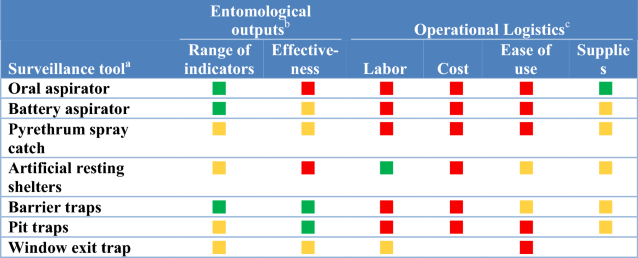
- aSurveillance tools included oral aspirator (includes manual aspirators); battery aspirators (CDC backpack aspirators, bazooka aspirators and Prokopack aspirators); Pyrethrum spray catches (pyrethrum spray and knockdown spray catches using a variety of natural and synthetic insecticides); artificial resting shelters (clay pot, and resting boxes); barrier traps (barrier screens and Malaise traps); pit traps (multiple iterations of a pit trap); window exit trap included a variety of window exit trap designs
- bThe entomological outputs assessed each tool as a function of the numbers of entomological indicators monitored by surveillance tool category and effectiveness. For “range of indicators”, a green square indicates the tool monitored more than one indicator in Table 3 while a yellow square indicated use for monitoring indicators varied by geographic location. A tool’s “effectiveness” was defined as a function of the numbers of specimens and/or species collected with green squares indicating that the tool was efficient in collecting adequate numbers of samples across a range of species while yellow squares indicated the tool collected fewer specimens, did not collect all species or effectiveness varies by location
- cGreen squares indicate that expert informants considered this tool to be advantageous in not requiring a lot of human input for establishing or maintaining, was inexpensive, easy to use and required minimal supplies or were easily accessible for “labour”, “cost”, “ease of use” (limited training required) and “supplies”, respectively. Red squares indicate that the tool had major limitations: high costs, was labour intensive or hard to use. Yellow squares indicated either a range of informant opinions as to operational utility

